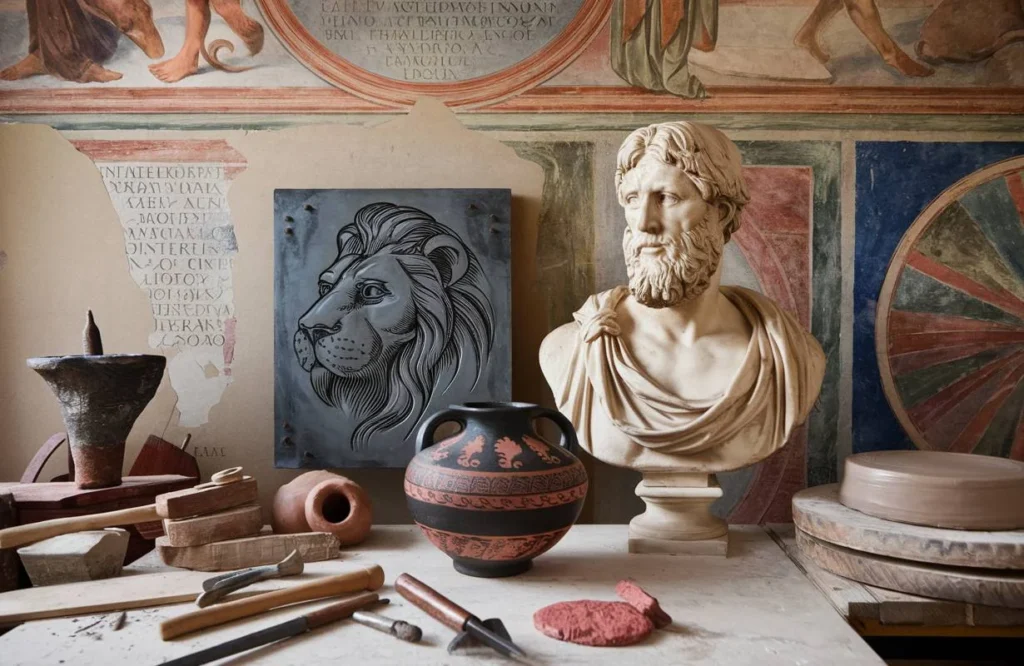Ancient Artz is one of the major cultural artifacts that humanity has created throughout time, and ancient art was no exception. This ongoing story is presented by ancient art as a fascinating chapter, demonstrating the creativity and technical power of early human societies along with interesting spiritual implications. By analyzing ancient art, this study explores where it may have begun and the history of several unique regions of the world that influenced its designs in various civilizations throughout history, with a legacy that continues today.
Introduction to Ancient Artz
Ancient artz refers to the general collections of some vast human cultures, including several prehistoric ones (literally before history, yes…) around the world for thousands of years, of various types and media [1]! ~wikimedia! From the primitive cave paintings of yesteryear to the complex sculptures created by civilizations as far away as ancient Greece and Rome, it gives us a unique insight into the lives, beliefs, and environments of our ancestors. While these works are a testament to the creativity of their creators, they also speak to how humans have evolved spiritually, technologically, and socially over time.
Definition and Scope
The subject of “Ancient Artz” can be said to roughly include, but is not limited to, prehistoric, Egyptian, Mosaic (Northern Mesopotamia), Greek, and Roman cultures, as well as continental cultures from well-known regions such as India/China to Mesoamerica. This can refer to paintings, sculptures, ceramics, and architecture, among others, which are the traces of a culture in history.
Origins of Ancient Artz
Origins of Ancient Artz: Classical marble bust of a woman in front of a Roman ruin, symbolizing the roots and eternal beauty of ancient art.
The journey into ancient artz begins with the earliest known human artworks, shedding light on the cognitive and cultural development of early humans.
Prehistoric Art
From cave paintings to ancient sculptures, prehistoric art was one of the most primitive forms of man; however primitive and simple it may be.
Cave Paintings
France: Lascaux Caves Discovered in 1940, the caves in France are some of the most famous and amazing works of art ever created. Some of them depict animals such as horses, deer, or bison and are approximately 17,000 years old. The paintings are characterized by being colorful and realistic in their depiction of animal behavior.
Venus figurines
For example, the Venus of Willendorf was discovered in Austria and dates back to approximately 28,000-25,000 BC, and while it is impossible to determine exactly what these small figurines represent, they are often associated with fertility symbols or paradigms of feminine beauty. Known for their emphasis on the female body and the early stages of symbolic thought.
Evolution of Ancient Artz
As human societies moved from nomadic agricultural lifestyles to sedentary agricultural lifestyles, art also began to evolve in its purpose and complexity.
Neolithic art
Farmers have the ability to create longer lasting works of art and this is how farming leads to the preservation of works. They recognized that Neolithic art, such as detailed pottery and engraved sculptures (like the frescoes at Çatalhöyük in Turkey), was key to understanding early urban life and religious beliefs.
Styles in Ancient Artz
Each ancient civilization had its own unique artistic style associated with the specific cultural values and technological capabilities they lived with.
Egyptian Art
The ancient Egyptians were renowned for the design of their art and for most of Egyptian history it was used daily in temples or tombs.
Hieroglyphics
Writing, an ancient artz writing system that used pictorial symbols to represent sounds and words. Through hieroglyphics, including religious texts and tomb inscriptions, as well as monumental architecture, a connection was made between art and language.
Sculptures and Statues
Egyptian sculptures, such as the colossal statues of Ramesses II and the Sphinx, were created to serve as reminders of the gods or pharaohs. The statues, as a rule, were in static, rigid poses and arranged frontally with proportions formed according to ideal types.
Frescos and Paintings

The walls of tombs and temples were decorated with Egyptian murals depicting everyday life, mythology, and the afterlife. These complex and vivid images were intended to make the deceased feel at home in their new surroundings, which was a good thing since they did a terrible job of depicting everyday life.
Greek and Roman Art in Ancient Artz
One of the main ways that Greek and Roman art inspired Western art was through its realism in terms of detail of the human form.
Greek art
Greek art is associated with idealism and proportions. Phidias’ works include, most famously (and controversially), Ancient Artz the Parthenon sculptures, in which he depicted and idealized the Olympian gods. The Greeks also created three orders of architecture: Doric, Ionic, and Corinthian.
Roman art
Although Roman art is very realistic and innovative in its approach. The Romans were excellent at creating realistic portraits and busts of emperors, such as the bust of Julius Caesar featured above. It demonstrates high standards of engineering with the most notable styles borrowed from Roman architecture, such as the Colosseum and the construction of aqueducts.
Chinese art
Chinese art spans thousands of years and is known for its unique characteristics, including an emphasis on harmony, balance, and naturalism.
Calligraphy
Considered a classical art form in China, calligraphy is the practice of creating artistic symbols using a brush and ink. Practice: All famous calligraphic works, such as Wang Xizhi’s “Preface to the Orchid Pavilion,” are valued not only for their content, but also for their craftsmanship and style.
Painting with ink and wash
In particular, it focuses on brushstrokes and ink to depict landscapes in all their natural beauty. Artists such as Wang Wei or Xu Wei used ink washes to express the simplicity and spirit of nature.
Ceramics
Chinese tradition, particularly during the Ming and Qing dynasties, may have produced some of the finest pieces of blue and white porcelain ever created. These ceramics also demonstrate China’s high level of firing technology and artistic awareness at the time.
Indian art
The spiritual and religious art of the Indian subcontinent reflects this diversity, influenced by Hindu, Sikh, Buddhist and Muslim cultures.
Sculpture
Indian sculpture, for example, features intricate carvings of deities and mythological scenes. Some of them, like the rock-cut temples of Ajanta and Ellora, have beautiful carvings of Buddha and some other religious images.
Temple architecture
Indian temple architecture is unique with its intricate patterns and tall spires. Structures like the Brihadeeswarar Temple in Tamil Nadu and the Kandariya Mahadev Temple in Madhya Pradesh clearly demonstrate the richness of Indian temple architecture.
Miniature painting
The colours used in that era for the fine Indian miniature paintings designed for the royal courts. The Mughal and Rajput schools of painting, in works such as Akbar Nama (1590s) and Ragamalas, depict scenes from court life, festive occasions, or reflect on historical events.
Mesoamerican art
There are few ancient artistic traditions in the world that are as well known (and yet as condensed) as those of the civilizations of Mesoamerica: mysterious peoples who built temples to barely identified gods and left decorative works that they imbued with religious significance.
Mayan art
Stelae and murals are the most common Mayan art depicting ruling figures, deities, and mythological events. Particularly famous are the Bonampak frescoes depicting Mayan rituals and ceremonies.
Aztec art
Aztec art was rich in intricate stone carvings and feather work. A huge basalt sculpture of Aztecs circling, called the Introduction of the Sun Stone, is one of the most famous works of Top 10 Wild Chelsea Art.
Olmec art
The Olmec are best known for their unusual dual heritage of huge basalt heads, which were probably portraits of rulers or gods. They are notable for their size and their distinctive, highly emotive heads.
Influence of Ancient Art
Preserving Ancient Art: A partially restored classical statue, surrounded by preservation tools such as paintbrushes and magnifying glasses, is installed in a conservation laboratory, highlighting efforts to protect and preserve ancient artworks.
Classical art had a lasting influence on art and tradition, as well as on the foundations of intellectual culture. This influence is felt in different areas of daily life.
Influence on Contemporary Art
We incorporate so many elements of each culture into our work because, much more than Greek poets or medieval artists, we can (partly through better and worse measures) even be aware of them.
Cultural Preservation of Ancient Art
Art has offered a means of looking back to times past, reminding us of all that we were and even what we are now: ancient art tells stories; stories about civilizations that once existed and their cultural beliefs.
Educational Value of Ancient Art
The study of ancient visual culture provides a basis for understanding the development of artistic techniques and cultural sensibilities in different periods and regions.
Conclusion on ancient art
Ancient Artz is a lavish world that, when revealed, reveals the creativity and human expression that has evolved into our cultural heritage. From the earliest cave paintings to the monumental legacies of ancient civilizations, the vitality of ancient art continues to inspire and enlighten us about past human eras. Studying these early works can deepen our understanding of how art has shaped humanity throughout history up to today.
Ancient art FAQ
- What are some examples of prehistoric ancient art?
Prehistoric art includes cave paintings from southwestern France, such as those at Lascaux, and statuettes of Venus. It offers one of the earliest impressions of human creativity and the use of symbols. - What distinguished ancient Egyptian art from Greek art?
Ancient Egyptian art is famous for its traditionalism, adhering to strict rules and conventions in an allegorical form depicting largely idealized representations of gods or people. Meanwhile, Greek art focused on realism and the perfect human form, as well as the idea of man in glorious form. - In general, what did ancient art consist of?
This meant that stone, wood, clay or metal were the most commonly used materials in ancient art. In each civilization, the use of these materials depended on their availability and aesthetic needs. - Why is it important to study ancient art?
The art of ancient civilizations carries cultural, social and technological meanings that we can draw from our history. And it tells us something about how people have been creative and expressive over time, and how this influences, if at all, current behavior (artistically or scientifically).










